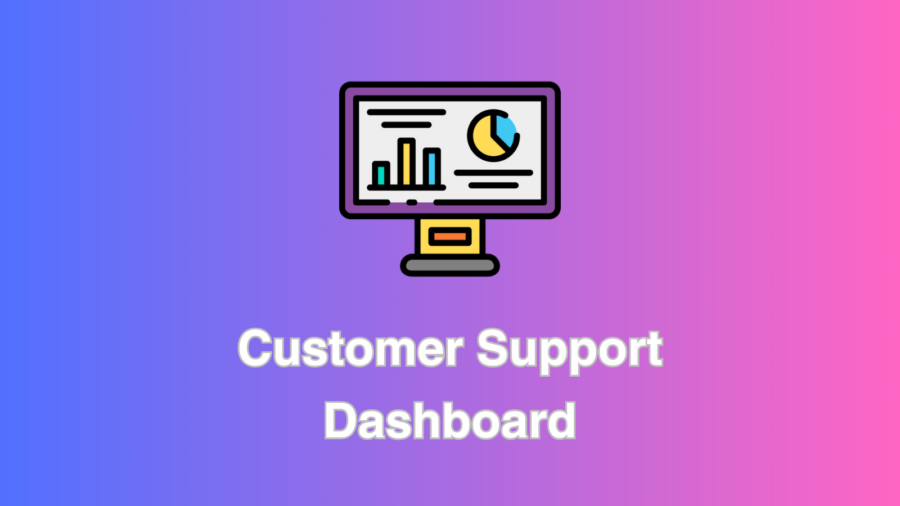Customer support plays a pivotal role in maintaining customer satisfaction and loyalty. As companies strive to deliver exceptional service, the need for insightful and actionable data becomes more critical. Enter the Customer Support Dashboard – a powerful tool that transforms raw data into meaningful insights, enabling businesses to make informed decisions and enhance the overall customer experience.
Understanding the Customer Support Dashboard
A Customer Support Dashboard is a centralized platform that consolidates and visualizes key performance indicators (KPIs) related to customer support operations. It provides a comprehensive overview of crucial metrics such as ticket resolution times, customer satisfaction scores, agent performance, etc. This real-time snapshot allows support teams and management to identify trends, address issues promptly, and streamline processes for maximum efficiency.
Creating a Customer Support Dashboard: Step-by-Step Guide
- Define Key Metrics:
Start by identifying the key metrics that align with your business goals. These could include average response time, ticket volume, resolution rate, and customer feedback scores. Clearly defining these metrics sets the foundation for a focused and effective dashboard. - Choose a Dashboard Platform:
Select a dashboard platform that suits your needs. Popular choices include tools like Tableau and Power BI or custom solutions using programming languages like Python or R. Ensure the platform allows real-time data integration for up-to-the-minute insights. - Data Collection and Integration:
Gather data from your customer support channels, CRM systems, and other relevant sources. Integrate this data seamlessly into your chosen dashboard platform. Automation is key here to ensure the dashboard reflects current information. - Design the Dashboard Layout:
Create a user-friendly layout that emphasizes clarity and accessibility. Arrange key metrics in a visually intuitive manner. Utilize charts, graphs, and color-coded indicators to make data interpretation quick and effortless. The goal is to provide an instant understanding of customer support performance. - Implement Filters and Drill-Down Options:
Enhance the user experience by incorporating filters and drill-down options. This allows users to focus on specific time frames, support channels, or agent performance, providing a more granular view of the data. - Include Performance Trend Analysis:
Implement trend analysis features to track performance over time. This not only helps in identifying patterns but also enables proactive decision-making based on historical data. Recognizing trends can be instrumental in forecasting and planning for future customer support needs. - Ensure Mobile Responsiveness:
In today’s dynamic business environment, accessibility is key. Ensure your Customer Support Dashboard is responsive on various devices, especially mobile phones and tablets. This empowers on-the-go decision-making for support teams and managers. - Regularly Update and Maintain:
Set up regular updates for your dashboard to ensure that the information is always current. Regular maintenance includes updating data sources, checking for anomalies, and incorporating any necessary changes based on evolving business requirements.
How Product Managers Can Leverage Customer Support Dashboards
Product managers play a crucial role in aligning product development with customer needs. The insights derived from a Customer Support Dashboard can provide valuable input for product improvement and innovation.
- Identifying Product Pain Points:
Analyzing customer support data can unveil recurring issues, or pain points customers experience with the product. Product managers can use this information to prioritize feature updates or bug fixes, ultimately enhancing the overall product experience. Customer Support Dashboard. - Optimizing Feature Adoption:
Product managers can tailor their communication and training strategies by understanding which product features generate the most support tickets or confusion. This ensures that users fully understand and efficiently use the features, reducing the strain on customer support resources. - Informed Decision-Making:
Armed with real-time data on customer inquiries and concerns, product managers can make informed decisions on product roadmaps. They can prioritize feature development based on user needs, leading to more customer-centric product updates.
Real-World Examples of Customer Support Dashboard Success Stories
Several companies have reaped the benefits of implementing robust Customer Support Dashboards. One example is a leading e-commerce platform that significantly improved customer satisfaction scores after identifying and addressing bottlenecks in its support ticket resolution process. The Customer Support Dashboard was pivotal in visualizing these inefficiencies and guiding the necessary process changes.
In another instance, a software-as-a-service (SaaS) company used a customized dashboard to monitor customer support response times. By analyzing this data, they could allocate resources more efficiently, reducing response times and enhancing overall customer satisfaction.
Conclusion
In conclusion, a well-designed Customer Support Dashboard is not just a tool; it’s a strategic asset that empowers businesses to deliver exceptional customer support. Organizations can gain valuable insights, optimize support processes, and ultimately elevate the customer experience by following a systematic approach to creating and utilizing these dashboards.
Customer Support Dashboard. As technology continues to evolve, so will these dashboards’ capabilities. Embrace the power of data visualization and turn your customer support operations into a well-oiled machine that resolves issues promptly and contributes to the ongoing improvement of your products and services.





